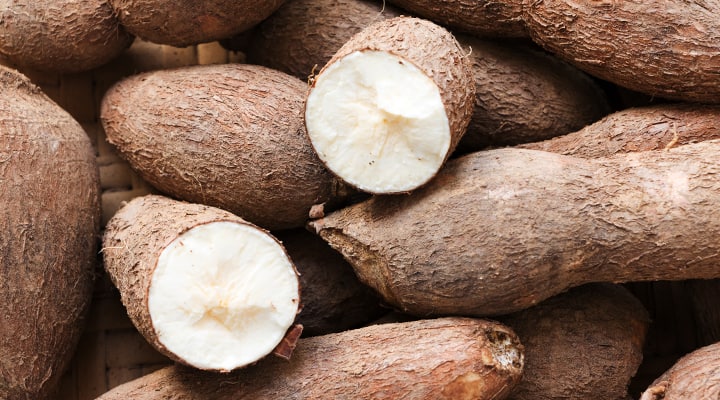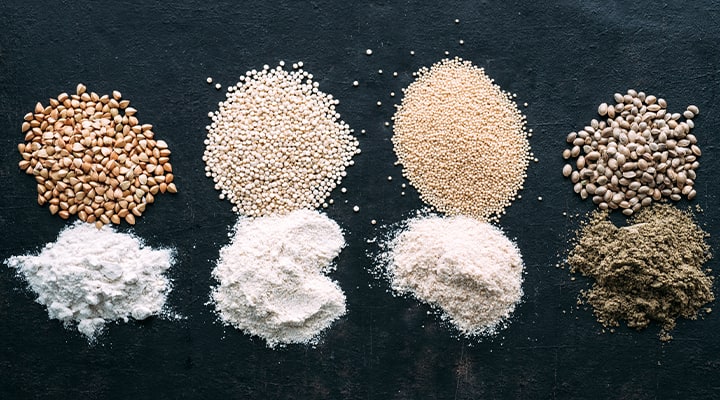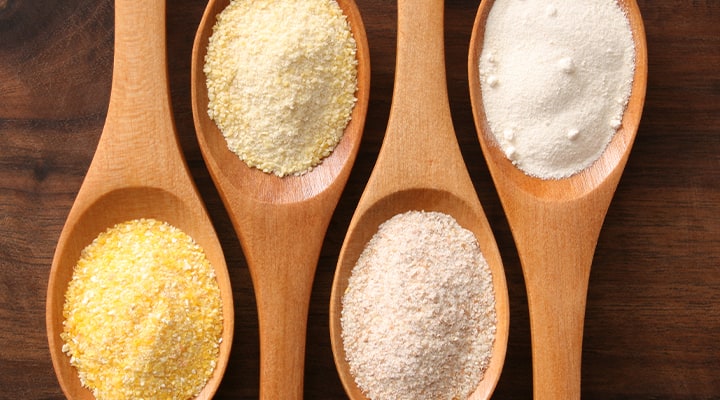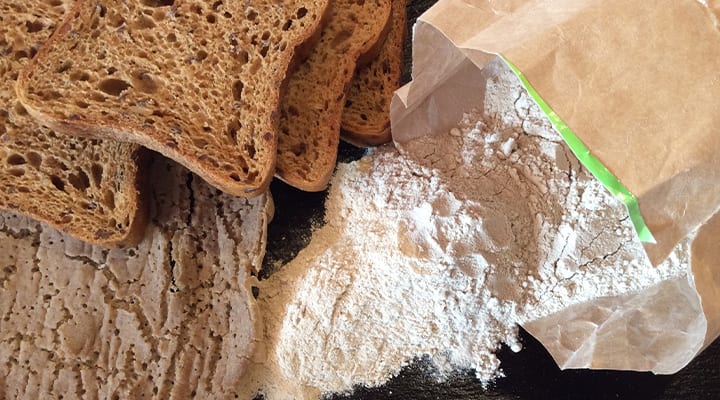
15 Wheat Flour Substitutes: Buying Guide
Published: July 2024
To say that Americans have a complicated relationship with wheat would be an understatement. We might love the taste, texture and even smell of freshly baked bread while we're eating it, but not feel so great afterward, either because our bellies don't agree with it, because we feel guilty about eating carbs, or both.
These complicated feelings extend into the health and wellness community, where wheat is often a topic of debate. On one hand, there is reason to consider whole grain wheat a heart-healthy, gut health-supporting food of nutritional value. After all, whole grain wheat is a source of vitamins, minerals, phytonutrients and prebiotic fiber.
On the other, there are also health reasons why someone may want to choose an alternative to wheat flour. These include: following a gluten-free diet, intolerance of wheat itself, and concerns related to the growing and production of wheat (the potential for non-organic varieties to retain chemical residue). And plenty of people stay away from starches because they're worried about blood sugar, cholesterol or weight management.
If you are someone in the latter category and are looking for a flour substitute, or maybe you are not sure either way, here is information to help you determine which type of flour to use and when.
What is flour?
Before we get too far, let's first explain what flour is and how it's made. It is not strictly a wheat product! This pantry staple is made by milling grains from cereal crops or even from nuts and seeds. Wheat "all-purpose flour" is the most popular type you'll find as an ingredient in baked goods like bread and for general use in cooking recipes. But there are many other options.
15 Flour Alternatives
1. Almond Flour
Almonds comprise one of the most popular nut-based flours and milk alternatives. Almond flour is made from whole almonds, including the skin, or from almonds that have been blanched first before being ground into a fine meal to mimic the consistency of wheat.
This flour substitute works well for both sweet and savory recipes. While it has been traditionally used as an ingredient in baked goods like French macarons, you can use it in place of breadcrumbs, and much more. If you are looking for a very low-carb, higher-protein option, try almond! Notably, this option contains the most fat. ¼ cup provides 12g unsaturated fat, 6g carbs (4g fiber, 2g sugar, 0g added), and 6g protein.
2. Coconut flour
In addition to its role as sub for grains, coconuts are a versatile fruit that can be used as a dairy alternative for milk, cream, and yogurt, as a cooking oil, a sugar alternative and more! If you enjoy this fruit's rich, slightly sweet flavor and texture, try it in pancakes, energy bites, protein truffle balls and more.
Due to the high fiber content, coconut flour absorbs more liquid than other flours and recipes including it often call for more eggs and liquid. It has the most sugar content among the alternatives. On the plus side, it's one of the most-high fiber options. Surprisingly, it's one of the most high-protein options, too. ¼ cup provides 2g saturated fat, 18g carbs (10g fiber, 6g sugar, 0g added), and 6g protein.
3. Oat flour
Made from milled whole grain oats, oat flour is one that can be easily made at home with rolled oats for your banana bread, dog treats, pancakes, muffins and other baked goods. While you have rolled oats on hand, you can also use this ingredient to make your own oat milk! Plus, oats are a source of lysine and beta glucans. ¼ cup provides 2g unsaturated fat, 22g carbs (3g fiber), 4g protein.
4. Chickpea/garbanzo bean flour
This flour is made from a nutritious legume that works well in savory dishes and is popular in Middle Eastern and Indian dishes. Chickpea also makes for a popular pasta alternative option. Try chickpea flour in falafels, crackers and crusts. It offers a nice amount of fiber and protein. ¼ cup provides 1.5g unsaturated fat, 21g carbs (5g fiber, 1g sugar, 0g added), 5g protein.
5. Rice flour
Rice flour is available as brown (whole grain) or white rice flour. Rice is a versatile grain that can be used to make flour, noodles, milk and more. While rice flour is generally not the most nutrient-dense choice, choosing the brown rice variety can provide a little more fiber and nutrition. It is starchy and higher in carbs compared to other options. ¼ cup provides 1g unsaturated fat, 32g carbs (1g fiber), and 3g protein.
6. Cassava flour
Also known as yuca, cassava is a tuber vegetable that grows underground. Cassava flour is made from almost the entire root portion of the plant (without the skin) and has a bit of a nutty flavor. You may have noticed that cassava flour is among the most popular alternatives to wheat flour used to make packaged snacks and gluten-free foods. In the kitchen, it can also be used to make baked goods, sauces and batters. Mostly carbs and some fiber, this flour offers negligible amounts of protein. ¼ cup provides 0g fat, 31g carbs (2g fiber), and 0g protein.
7. Tapioca flour
Have you enjoyed a boba tea or Brazilian cheese bread? Then you've tried tapioca before! Tapioca is actually also derived from the cassava plant, but the flour is made from the pulp of the root, which is the starchy portion. This is why tapioca flour is also known as tapioca starch. While it won't offer as much nutritional value as cassava flour, especially in the fiber department, it plays a valuable role in gluten-free dishes and can even serve as a substitute for corn starch. ¼ cup provides 0g fat, 27g carbs, and 0g protein.
8. Teff flour
If you have ever eaten at an Ethiopian restaurant, you likely tried a crepe-like bread made from teff called injera, which is a staple at almost every Ethiopian meal. Teff is considered an "ancient" grain from east Africa. It is also a gluten-free grain. Teff grains are very small and teff flour is typically made from the whole grain, proving the nutritious bran and germ. ¼ cup provides 1g unsaturated fat, 24g carbs (2g fiber, 1g sugar, 0g added), and 4g protein.
9. Amaranth flour
Fun fact: amaranth seeds get their name from the Greek word for "immortal." Amaranth is a pseudograin (aka pseudocereal) because it is technically not a true grain grown from grasses. Through botanically different, pseudograins are generally considered whole grains as they are used and consumed in a similar manner. Notably, amaranth is a source of the amino acid lysine, which is absent from some other grains. Add amaranth to your bread dough or enjoy it as a breakfast porridge. It will offer a good amount of fiber, protein, and iron, too! ¼ cup provides 2g unsaturated fat, 25g carbs (4g fiber, 1g sugar), 5g protein, and 3mg iron.
10. Buckwheat flour
Despite having the word "wheat" in its name, buckwheat is a gluten-free, ancient pseudograin that is notoriously used to make soba, a type of Japanese noodle. And if you've ever enjoyed blinis with caviar at a celebration, the eastern European pancakes may have been made with buckwheat flour. Notably, this flour sub provides a hefty serving of fiber, along with some decent protein. ¼ cup provides 0.5g unsaturated fat, 29g carbs (9g fiber), and 4g protein.
11. Quinoa flour
Like amaranth and buckwheat, quinoa is another ancient pseudograin that can be ground for use as a flour. Though native to South America, quinoa has become a popular choice in the US in recent years for its amino acid profile. It can serve as a more nutrient-dense substitute for rice to accompany your meals. If you find the earthy flavor too strong, try it with recipes that include lemon or spices. Try the flour in your crackers and baked goods. ¼ cup provides 1g unsaturated fat, 19g carbs (3g fiber, 1g sugar, 0g added), and 4g protein.
12. Millet flour
Millet is an ancient grain that can be made into a whole grain flour. Its mild flavor makes it a good option for both sweet and savory dishes. Try using it for a gluten-free loaf recipe. ¼ cup provides 2g unsaturated fat, 31g carbs (1g fiber), and 4g protein.
13. Corn flour (maize)
Though cornbread typically calls for corn meal, if you want a less crumbly result, try using whole grain corn flour, which is texturally more similar to all-purpose flour. You can also use it to make waffles and other recipes. ¼ cup provides 1g unsaturated fat, 24g carbs (3g fiber, 1g sugar, 0g added), and 2g protein.
14. Rye flour
As a relative of wheat, rye is a gluten-containing grain and is sometimes considered more nutritious. Bread may be the first thing to come to mind, but rye can be used for crackers, pizza crust and baked goods. ¼ cup provides 0g fat, 23g carbs (3g fiber, 0g sugar) and 4g protein.
15. Sorghum flour
This gluten-free whole grain is among the top 5 cereal crops used around the world. Sorghum is a staple in India and Africa and is used as a syrup in American southern states. Try the flour in dinner rolls and more! ¼ cup provides 0.5g fat, 28g carbs (2g fiber), and 3g protein.
Pro tip: With the exception of rye flour, all the other options on this list are inherently gluten-free. Though many of these options cannot be substituted cup-for-cup with wheat flour, as a general rule of thumb, you can often replace up to 25% percent of all-purpose flour in a recipe with these alternatives. Gluten-free flour blends are also available as a 1-to-1 swap.
Explore Our Best Digestive Health Supplements
Wheat Flour Cheat Sheet
If you're good with wheat flour, figuring out which type to use can still be mystifying. Here's a quick guide to understanding the various types:
All-purpose flour –
Can be used for pretty much anything that calls for flour, has moderate protein (10-12%), and is only made from the endosperm, excludes the germ and bran.Whole grain wheat flour
– Used as a more nutrient-dense alternative to the more refined versions of wheat flour, includes the germ and bran, is higher in protein (13-15%), and is the highest-fiber option among wheat flours (~5g per ¼ C).Bread flour
– Gives texture to bread; higher in protein (12-14%).Cake flour
– This flour is finer ground, and has the lowest protein content (5-8%).Pastry flour
– Used to make pastries; lower protein.Semolina flour
– Most commonly used to make pasta; higher in protein.Double zero "00" flour
– Most commonly used to make pizza, this flour has a very fine texture (powdery) with a moderate amount of protein.
What is the healthiest type of flour?
When we talk about the word "healthiest," this depends on the individual. So, if someone cannot tolerate wheat proteins, then that automatically means wheat flour is not the healthiest option for them.
So how do you know which to choose? Nutrient-dense foods offer us important macronutrients (carbs, protein, fats) and micronutrients (vitamins, minerals). Let's compare and contrast the various options, starting with protein and fiber content.
Best source of fiber: Buckwheat and coconut.
The fiber content of wheat flours ranges from approximately 1-5g per serving, with whole grain wheat offering the most. For wheat alternatives, fiber content ranges from approximately 1-10g, with buckwheat flour and coconut flour offering the most. Why this matters: Fiber will help with a more stable digestion of carbohydrates.Best sources of protein: Almond or coconut.
The protein content of wheat flours range from approximately 3-6g per serving, with whole grain wheat and semolina on the higher end. So keeping in mind that some flour alternatives will offer considerably less than this, the protein content ranges from approximately 0-6g per serving, with almond flour and coconut flour being on the higher end.Lowest carb flour substitute: Almond flour.
This nutty flour has the lowest amount of carbs, most of which is fiber. On the other hand, rice flour has more carbs per serving than your typical wheat flour.Lowest fat content: Wheat, rye or cassava.
All wheat flours contain very little fat content, 1g or less. Notably, almond flour provides 12g of unsaturated fat per serving.
Important caveats: the nutritional values of flours will vary depending on the brand. (The macronutrient profiles listed in this article are based on Bob's Red Mill nutrition facts labeling.) Product cost and environmental sustainability are also factors for some. Also, alternatives can contain non-nutritive minerals (heavy metals) and chemical residues from non-organic varieties (as can wheat), which may be a consideration. In 2024, products made with cassava and chickpeas raised concern in these areas.
Which flour alternatives have the most vitamins and minerals?
Figuring out which flour alternatives are the "best" sources of micronutrients can really send you down a rabbit hole since some of this varies according to the manufacturer. Fortunately, a research paper published by the Journal of Cereal Science conducted testing of the nutritional properties of commercial gluten-free flours made from rice, oat, quinoa, buckwheat, sorghum, corn and teff compared to wheat flours:
- Calcium: Teff contains 30 times more calcium than rice and over 47 times more than corn flour. The calcium content of quinoa is also higher than in other gluten-free raw materials tested.
- Magnesium: Incorporation of quinoa, buckwheat and teff flour would have a positive influence on magnesium levels, helping people meet their daily requirements for this mineral.
- Iron: Sorghum, rice and corn flour do not contain iron. On the contrary, teff, quinoa and buckwheat flour show a high iron level.
- Phytates and minerals: Despite quinoa and teff showing a favorable mineral composition, their high phytic acid levels are considered an anti-nutritional factor, since this compound binds minerals. (Though this is generally not something to be overly concerned about if consuming a varied diet). Under conventional processing conditions such as pasta or bread making, optimal conditions for the degradation of phytate are rarely reached. However, sourdough fermentation provides optimum pH conditions for phytase to break down phytic acid.
- Vitamin B9 folate: The highest folate contents were detected in the flours of the pseudocereals quinoa and buckwheat.
- Polyphenols: Compared to all other cereals screened, buckwheat flour showed the highest polyphenol content, followed by teff flour.
- Amino acids: Pseudocereals are known for their high lysine contents. Quinoa and buckwheat are also superior regarding protein digestibility, net protein utilization and protein efficiency ratio.
Do different flours taste different?
Yes. The flavor of flours will vary depending on what they are sourced from. Almond flour will be nutty, cassava has also been described as nutty, coconut tends to be rich and a little sweet, quinoa can be earthy (and sometimes a little bitter), millet is mild, and corn has some sweetness too.
And since enjoying your food is an important part of nutrition, definitely consider your taste buds when choosing a flour, especially since each of these options offers a variety of health benefits!
References
- Hager AS, et al. "Nutritional properties and ultra-structure of commercial gluten free flours from different botanical sources compared to wheat flours." Journal of Cereal Science. September 2012. https://www.sciencedirect.com/science/article/abs/pii/S0733521012001221
- Kirchner L. "Cassava-Based Puffs From Lesser Evil and Serenity Kids Contain High Levels of Lead." Consumer Reports. June 2024. https://www.consumerreports.org/health/food-safety/lesser-evil-serenity-kids-cassava-puffs-high-lead-levels-a2654657249/
- Wang Y, Jian C. "Sustainable plant-based ingredients as wheat flour substitutes in bread making." NPJ Sci Food. October 2022. https://www.ncbi.nlm.nih.gov/pmc/articles/PMC9614748/
- "Baking Flours." Bob's Red Mill. https://www.bobsredmill.com/shop/flours-and-meals.html
Like what you read?
Please subscribe to get email updates on this blog.












